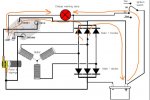tim292stro
Well-known member
- 2,117
- 40
- 48
- Location
- S.F. Bay Area/California
With the wear and tear you apparently do to yourself - I think you've earned a few "easy ways"...It seems the older I get, the less my brain wants to work...

It won't affect the efficiency much at all - the part of the rheostat that touches the coil (which is aptly called the "wiper") is designed to mechanically clean the contact surface as it moves. If the rheostat has dead spots or the wiper isn't doing its job any more, it's best to just replace the light switch ($17 at LMC, probably cheaper elsewhere...)....I do have a question for you though - do you think cleaning the rheostat in the light switch would affect the efficiency of the dash lights? I catch myself wanting to turn that darn knob just a little further each time to increase brightness...
[EDIT:] I wanted to point out that for low-current potentiometers like what you'd find in a stereo volume control, yes cleaning would be useful every once in a while. However, this is a higher current potentiometer (one one leg of the resistance element is hooked up so it is called a rheostat). For higher current contacts, they are designed to self clean with the power that is transmitted across the terminals. Different alloys are used with different current levels, gold/carbon/conductive-plastic for very low currents (20mA and below), copper and copper alloys for medium currents (20mA to about 100Amps), and silver and silver alloys for much higher currents (100A +).[/EDIT]
If your dash lights are dim, start with replacing the bulbs or converting them to LED - 1Watt of LED is much more light than 1Watt of incandescent (>90% of that 1Watt is infrared with an incandescent bulb). If you find that is still not enough, you can disassemble the cluster and re-paint the insides with fresh satin white (Krylon Fusion 2420) as they may have yellowed over the years of exposure to bulb heat. You have to fully disassemble the cluster, contacts and flex board to keep from covering anything important with paint. Only takes about 10 minutes to do.
Last edited:



